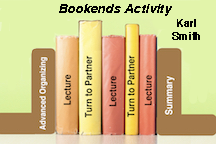Bookends Activity

Bookends is a simple model for including short, basic active learning tools such as Think-Pair-Share, Knowledge Check, etc within traditional lecture presentations. The typical process is to break a presentation into three smaller 10-12 minute segments and then insert the two short, appropriate 4-5 minute active learning activities between each lecture segment.
Why It Works
Human interest and engagement levels have a natural tendency to fall during extended periods passive engagement in traditional lecture type environments.
Taking short breaks in traditional presentations for active learning and participation allows students to engage with content in new ways like summarizing, comparing-contasting, sharing problem areas, or cooperatively solving problems. These short breaks can positively impact engagement in following class segments as well and if shared communally may help more students to master important concepts.
Implementation
The bookends model is a simple, low-risk, flexible teaching model. It's easy to plan for and implement and has the added advantage of encouraging you to try out multiple different types of small active learning strategies.
The steps below will help you to build a Bookends model experience within one of your lectures.
1. Select a lecture with content that may be challenging to your students
2. Think about ways to segment your lecture in three parts with two active learning activities in between the lecture segments
(Typical time arrangements might be Lecture Part 1. 15 min. + active discussion + Lecture Part 2. + active discussion + Lecture/summary, Part 3.)
3. Now select two activities from the list below to allow your students opportunity to actively engage with each other
- Have student discuss an important question for a Think-Pair Share
- One sentence summary of most important ideas covered
- Encourage students to try explaining the main concepts of lecture to a partner
- Ask student to create a "Compare/Contrast" chart of two important ideas in lecture
- Have your students identify the "Muddiest Point" a.k.a. the most poorly undestood part of content
- Allow student to work together to solve an application or sample problems
4. Insert these two active learning breaks in between your lecture segements.
NOTE: Theres no "right or wrong" order for your active learning activities, but if you think carefully about your lecture segments you may find some active learning activies will fit better than others in helping students master specific types of content.
Video Exemplars
Video Exemplars coming soon!
Research Evidence
Content Description: Controlled experiment to determine the effect of pausing procedures (three 2-minute pauses spaced at logical breaks during lecture) on free recall of facts and performance on objective tests. Students in the break/pausing group scored significantly higher on both recall and objective tests than did the control group.
Ruhl, Hughes & Schloss (1987). Using the Pause Procedure to Enhance Lecture Recall. Teacher Education and Special Education, 10(14).